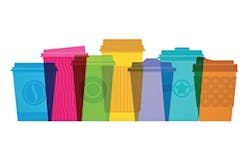Nearly a year ago, I wrote in an editorial here about the then-relatively new effort to ban plastic drinking straws (read the editorial here: www.bit.ly/2UkxYjN). The movement has taken off in a big way since then. A number of companies have pledged to eliminate plastic straws, stirrers, and other single-use plastic items in their stores and restaurants—Starbucks, Disney, and Ben & Jerry’s among them. Several cities have passed ordinances either banning these items or preventing restaurants and other vendors from handing them out unless customers ask for them—an intermediate step, in some cases, to an outright ban.
These measures are a start, but the problem runs deeper. Consumers can fairly easily understand the problem with straws, especially if they’ve seen the now-infamous video of biologists yanking a plastic straw from the nostril of a hapless sea turtle (the video can be viewed here: www.bit.ly/1DRmE4H). They understand that a great deal of the plastic we discard makes its way into the water, and potentially into the food chain. Many cities and states now have trash TMDLs mandating that a certain percentage—sometimes virtually all—trash gets intercepted before it hits the rivers, lakes, or ocean.
But some sources of plastic are harder to see, and some things that seem to be fairly innocuous, environmentally speaking, really aren’t. For example, paper cups—the kind your morning coffee might come in if you pick it up on the way to work—appear to be biodegradable, but most include a thin layer of plastic to stop the cup from leaking and to provide insulation. Although you might drop your cup into a recycling bin, many recycling facilities don’t have a way to process it; they can’t easily separate the plastic from the cardboard, and there’s a good chance that your cup will end up in a landfill or, worse, will be left for the cardboard to biodegrade while the plastic survives and ends up in the river.
This issue has gotten lots of publicity in recent months—many of us really don’t want to give up our coffee, so this tends to get our attention. Several solutions have been proposed. One is for recycling facilities that can’t handle the cups to collect them and send them to facilities that can; this is possible to do, but adds time and expense to a process that’s already operating with a thin profit margin. Another is to retool the cups themselves. Starbucks, McDonald’s, and other companies have agreed to take steps to do that—in the UK they’re signing the “Paper Cup Manifesto,” a pledge to increase recycling rates—and some are experimenting with a new type of cup whose lining is more easily separated from the paper. More recycling facilities should be able to handle them, filtering out the plastic liners and sending the rest on through.
In terms of the tremendous amount of plastic produced in the world—about 350 million tons a year—cup liners and drinking straws make up a relatively small percentage. But movements like these, in addition to removing at least some of the plastic from the waste stream, also serve to make people aware of the larger issues. What else would you suggest—either as an educational tool or as a practical strategy? Leave a comment below.






